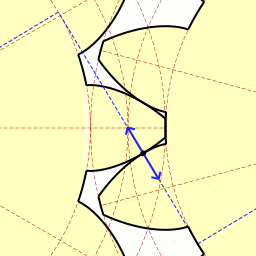is the most commonly used system and is the curve that is traced by a
point on a taut cord unwinding from a circle, which is called a base circle.
The involute is a form of spiral, the curvature of which becomes straighter
as it is drawn from a base circle and becomes a straight line at infinity.
An involute drawn from a small base circle is more curved than one drawn
from a larger base circle.
This design keeps all contact between gears in a flat plane as the teeth
mesh in and out. The contacting surfaces are always perpendicular to the
plane of contact, so the dominant contact forces (in a well lubricated
system) are always parallel to the plane. This way the moment arms are kept
constant. This is key to minimizing the torque/speed variations which
produce vibration and noise in lower quality gears. Note that the involute
profile does not prevent the teeth from scraping each other every time they
mesh, and this is the dominant source of wear. It is not possible to design
a gear tooth profile which rolls through the mesh without friction. Service
life is often managed by using hard materials and constant lubrication. When
friction wear is a critical issue,
chain
drives can help reduce maintenance requirements.
Note: The blue arrows shows the contact forces. The force line runs along
common tangent to base circles
